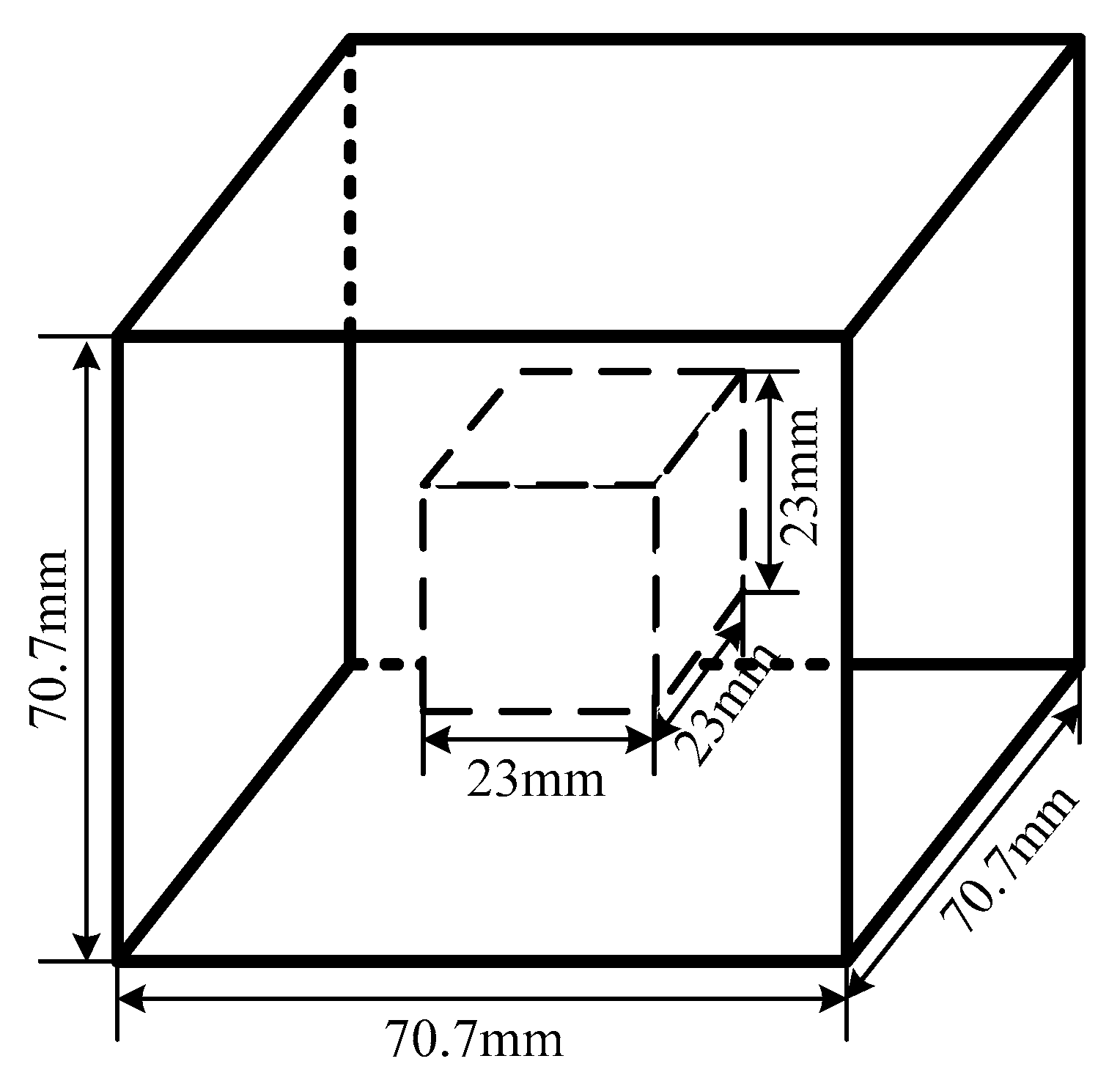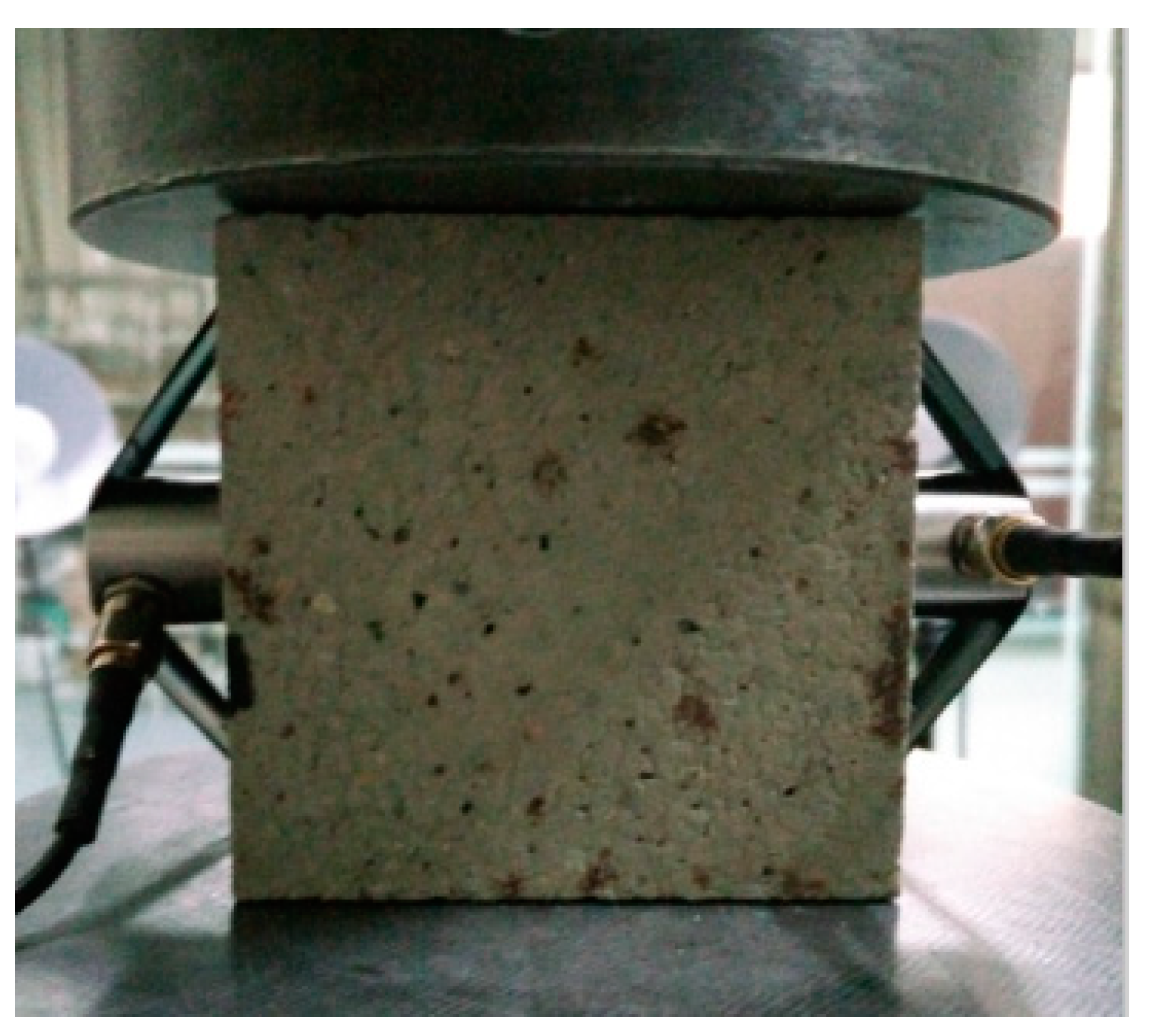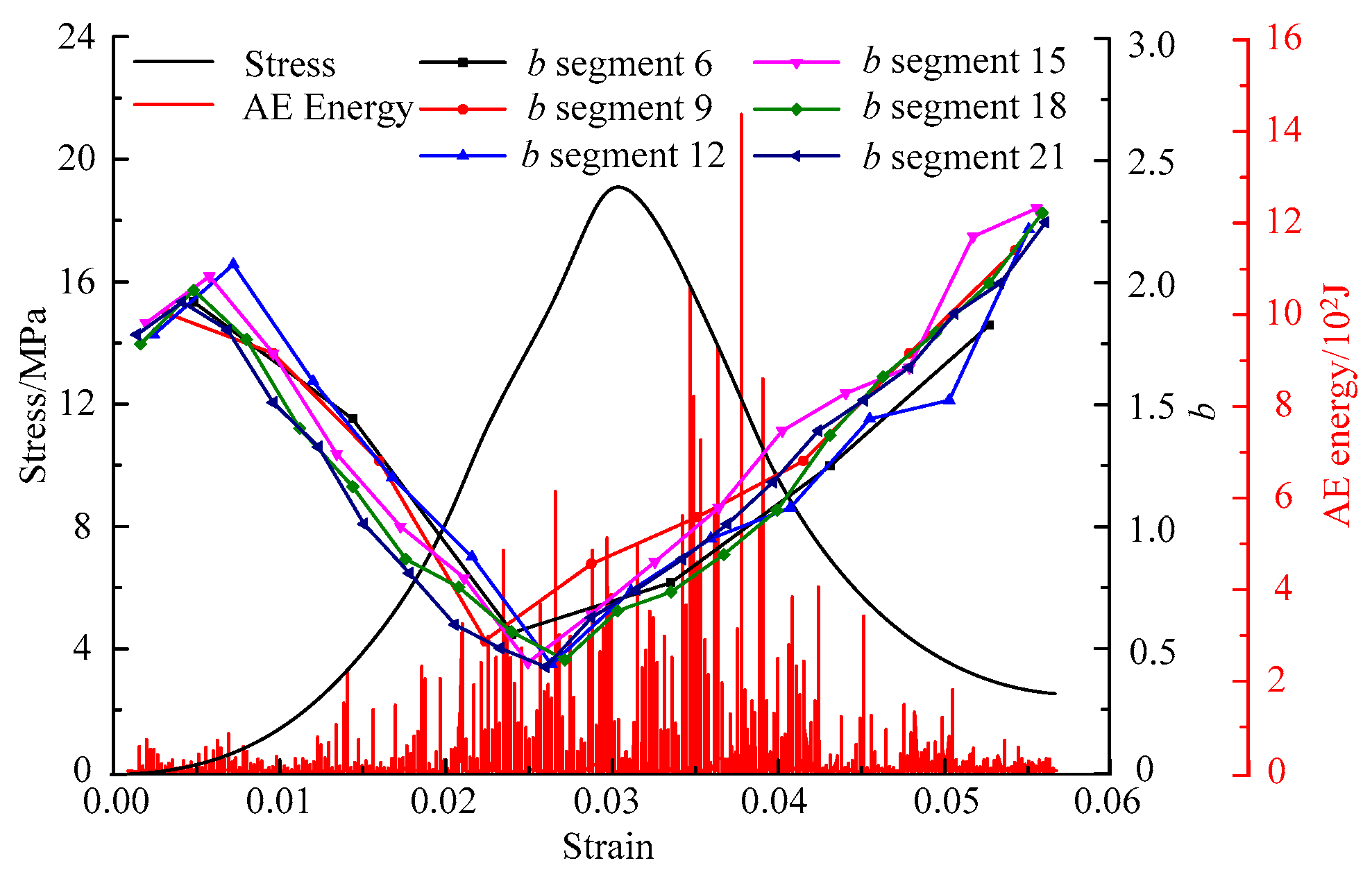Mechanical Characteristics and Failure Prediction of Cement Mortar with a Sandwich Structure
Abstract
:1. Introduction
2. Materials and Experiments
2.1. Materials
2.2. Sample Preparation
- Put all the raw materials on the weighing scales, then put them into a blender for mixing.
- Pour the mixed mortar material into a mold gradually, and tamp down the material with a tamping hammer until the compacted material fills one third of the mold.
- Put the sandwich material in the middle of the trial mold, then pour the mixture into the remaining space. Tamp down the material by tamping the hammer frequently.
- Put the test mold with the compacted mortar material on the vibration table with a slight vibration to make the mixture uniform. Tamp down the mixture by tamping the hammer again.
- Keep the mold with mortar material in a sealed state for 24 h, then remove all specimens from the mold and put them in a curing tank for 28 days.
2.3. Experimental Equipment and Procedure
3. Results and Discussion
3.1. Strength and Deformation Behavior
3.2. Acoustic Emission Characteristics
3.3. Failure Observations
3.4. Failure Prediction Based on AE Energy
3.5. Validation of the Prediction Method
4. Conclusions
Author Contributions
Funding
Acknowledgments
Conflicts of Interest
References
- Li, Y.; Wu, H.X.; Shi, Z. Farmland productivity and its application in spatial zoning of agricultural production: A case study in Zhejiang province, China. Environ. Earth Sci. 2016, 75, 1–17. [Google Scholar] [CrossRef]
- Zhang, J.X.; Li, M.; Taheri, A.; Zhang, W.Q.; Wu, Z.Y.; Song, W.J. Properties and Application of Backfill Materials in Coal Mines in China. Minerals 2019, 9, 53. [Google Scholar] [CrossRef]
- Chu, C.F.; Deng, Y.F.; Zhou, A.N.; Feng, Q.; Ye, H.; Zha, F.S. Backfilling performance of mixtures of dredged river sediment and iron tailing slag stabilized by calcium carbide slag in mine goaf. Constr. Build. Mater. 2018, 189, 849–856. [Google Scholar] [CrossRef]
- Ning, J.G.; Liu, X.S.; Tan, J.; Gu, Q.H.; Tan, Y.L.; Wang, J. Control mechanisms and design for a ’col-backfill-gangue’ support system for coal mine gob-side entry retaining. Int. J. Oil Gas Coal Technol. 2018, 18, 444–465. [Google Scholar] [CrossRef]
- Huang, Y.; Yang, Y.; Li, J.L. Numerical simulation of artificial groundwater recharge for controlling land subsidence. KSCE J. Civ. Eng. 2015, 19, 418–426. [Google Scholar] [CrossRef]
- Wu, J.C.; Shi, X.Q.; Xue, Y.Q.; Zhang, Y.; Wei, Z.X.; Yu, J. The development and control of the land subsidence in the Yangtze Delta, China. Environ. Geol. 2008, 55, 1725–1735. [Google Scholar] [CrossRef]
- Zhang, Y.; Wu, J.C.; Xue, Y.Q.; Wang, Z.C.; Yao, Y.G.; Yan, X.X.; Wang, H.M. Land subsidence and uplift due to long-term groundwater extraction and artificial recharge in Shanghai, China. Hydrogeol. J. 2015, 23, 1851–1866. [Google Scholar] [CrossRef]
- Li, L.; Wu, K.; Zhou, D.W. Evaluation theory and application of foundation stability of new buildings over an old goaf using longwall mining technology. Environ. Earth Sci. 2016, 75, 763. [Google Scholar] [CrossRef]
- Feng, X.J.; Zhang, Q.M. The Effect of Backfilling Materials on the Deformation of Coal and Rock Strata Containing Multiple Goaf: A Numerical Study. Minerals 2018, 8, 244. [Google Scholar] [CrossRef]
- Li, H.J.; Liu, S.Y.; Tong, L.Y. Field investigation of the performance of composite foundations reinforced by DCM-bored piles under lateral loads. Constr. Build. Mater. 2018, 170, 690–697. [Google Scholar] [CrossRef]
- Isobe, K.; Kimura, M.; Ohtsuka, S. Design approach to a method for reinforcing existing caisson foundations using steel pipe sheet piles. Soils Found. 2014, 54, 141–154. [Google Scholar] [CrossRef] [Green Version]
- Bouassida, M.; Carter, J.P. Optimization of Design of Column-Reinforced Foundations. Int. J. Geomech. 2014, 14, 04014031. [Google Scholar] [CrossRef]
- Zhao, Y.; Soltani, A.; Taheri, A.; Karakus, M.; Deng, A. Application of slag-cement and fly ash for strength development of cemented paste backfills. Minerals 2019, 9, 22. [Google Scholar] [CrossRef]
- Zhang, J.; Deng, H.; Taheri, A.; Deng, J.; Ke, B. Effects of superplasticizer on the hydration, consistency, and strength development of cemented paste backfill. Minerals 2018, 8, 381. [Google Scholar] [CrossRef]
- Cao, S.; Yilmaz, E.; Song, W.D. Evaluation of Viscosity, Strength and Microstructural Properties of Cemented Tailings Backfill. Minerals 2018, 8, 352. [Google Scholar] [CrossRef]
- Yin, Y.C.; Zhao, T.B.; Zhang, Y.B.; Tan, Y.L.; Qiu, Y.; Taheri, A.; Jing, Y. An Innovative Method for Placement of Gangue Backfilling Material in Steep Underground Coal Mines. Minerals 2019, 9, 107. [Google Scholar] [CrossRef]
- Wang, Y.Y.; Taheri, A.; Xu, X. Application of Coal Mine Roof Rating (CMRR) in Chinese coal mines. Int. J. Min. Sci. Tech. 2018, 28, 491–497. [Google Scholar] [CrossRef]
- Jiang, G.Z.; Wu, A.X.; Wang, Y.M. Low cost and high efficiency utilization of hemihydrate phosphogypsum: Used as binder to prepare filling material. Constr. Build. Mater. 2018, 167, 263–270. [Google Scholar] [CrossRef]
- Li, M.; Zhang, J.X.; Sun, K.; Zhang, S. Influence of Lateral Loading on Compaction Characteristics of Crushed Waste Rock Used for Backfilling. Minerals 2018, 8, 552. [Google Scholar] [CrossRef]
- Weng, L.; Li, X.; Taheri, A.; Wu, Q.; Xie, X. Fracture evolution around a cavity in brittle rock under uniaxial compression and coupled static-dynamic loads. Rock Mech. Rock Eng. 2018, 51, 531–545. [Google Scholar] [CrossRef]
- Akdag, S.; Karakus, M.; Taheri, A.; Nguyen, G.; He, M. Effects of thermal damage on strain burst mechanism for brittle rocks under true-triaxial loading conditions. Rock Mech. Rock Eng. 2018, 51, 1657–1682. [Google Scholar] [CrossRef]
- Liu, X.S.; Tan, Y.L.; Ning, J.G.; Lv, Y.W.; Gu, Q.H. Mechanical properties and damage constitutive model of coal in coal-rock combined body. Int. J. Rock Mech. Min. 2018, 110, 140–150. [Google Scholar] [CrossRef]
- Wang, X.; Wen, Z.J.; Jiang, Y.J.; Huang, H. Experimental study on mechanical and acoustic emission characteristics of rock-like material under non-uniformly distributed loads. Rock Mech. Rock Eng. 2018, 15, 729–745. [Google Scholar] [CrossRef]
- Gu, Q.H.; Ning, J.G.; Tan, Y.L.; Liu, X.S.; Ma, Q.; Xu, Q. Damage constitutive model of brittle rock considering the compaction of crack. Geomech. Eng. 2018, 15, 1081–1089. [Google Scholar]
- Guo, W.Y.; Zhao, T.B.; Tan, Y.L.; Yu, F.H.; Hu, S.C.; Yang, F.Q. Progressive mitigation method of rock bursts under complicated geological conditions. Int. J. Rock Mech. Min. 2017, 96, 11–22. [Google Scholar] [CrossRef]
- Meng, T.; Qiang, Y.J.; Hu, A.F.; Xu, C.T.; Lin, L. Effect of compound nano-CaCO3, addition on strength development and microstructure of cement-stabilized soil in the marine environment. Constr. Build. Mater. 2017, 151, 775–781. [Google Scholar] [CrossRef]
- Tan, Y.L.; Liu, X.S.; Ning, J.G.; Lu, Y.W. In situ investigations on failure evolution of overlying strata induced by mining multiple coal seams. Geotech. Test. J. 2017, 40, 244–257. [Google Scholar] [CrossRef]
- Li, J.M.; Huang, Y.L.; Chen, Z.W.; Li, M.; Qiao, M.; Kizil, M. Particle-Crushing Characteristics and Acoustic-Emission Patterns of Crushing Gangue Backfilling Material under Cyclic Loading. Minerals 2018, 8, 244. [Google Scholar] [CrossRef]
- Karimi, N.Z.; Minak, G.; Kianfar, P. Analysis of damage mechanisms in drilling of composite materials by acoustic emission. Compos. Struct. 2015, 131, 107–114. [Google Scholar] [CrossRef]
- Wasantha, P.L.P.; Ranjith, P.G.; Shao, S.S. Energy monitoring and analysis during deformation of bedded-sandstone: Use of acoustic emission. Ultrasonics 2014, 54, 217–226. [Google Scholar] [CrossRef] [PubMed]
- Chacon, J.L.F.; Kappatos, V.; Balachandran, W.; Gan, T.H. A novel approach for incipient defect detection in rolling bearings using acoustic emission technique. Appl. Acoust. 2015, 89, 88–100. [Google Scholar] [CrossRef]
- Cai, Y.D.; Liu, D.M.; Mathews, J.P.; Pan, Z.J.; Elsworth, D.; Yao, Y.B.; Li, J.Q.; Guo, X.Q. Permeability evolution in fractured coal-Combining triaxial confinement with X-ray computed tomography, acoustic emission and ultrasonic techniques. Int. J. Coal Geol. 2014, 122, 91–104. [Google Scholar] [CrossRef]
- Abdelrahman, M.; Elbatanouny, M.K.; Ziehl, P.H. Acoustic emission based damage assessment method for prestressed concrete structures: Modified index of damage. Eng. Struct. 2014, 60, 258–264. [Google Scholar] [CrossRef]
- Ministry of Construction of China. Standard for Test Method of Performance on Building Mortar (JGJ/T70-2009); State Standard of the People’s Republic of China; China Building Industry Press: Beijing, China, 2009. [Google Scholar]
- Gutenberg, B.; Richter, C.F.; Benioff, H. Earthquake study in southern California, 1948. Trans. Am. Geophy. Union. 1949, 30, 595–597. [Google Scholar] [CrossRef]
- Lei, X.L.; Ma, S.L. Laboratory acoustic emission study for earthquake generation process. Earth. Sci. 2014, 27, 627–646. [Google Scholar] [CrossRef] [Green Version]
- Suzukia, T.; Ohtsub, M. Damage estimation of concrete canal due to earthquake effects by acoustic emission method. Constr. Build. Mater. 2014, 67, 186–191. [Google Scholar] [CrossRef]
- Sagara, R.V.; Raob, M.V.M.S. An experimental study on loading rate effect on acoustic emission based b-values related to reinforced concrete fracture. Constr. Build. Mater. 2014, 70, 460–472. [Google Scholar] [CrossRef]









| Sandwich Material | Group | Cement–Sand Ratio | E (GPa) | UCS (MPa) | Peak Strain | Intrinsic b Value bd |
|---|---|---|---|---|---|---|
| Iron | A1 | 1:2 | 1.017 | 14.954 | 0.0352 | 0.324 |
| A2 | 1:1.5 | 1.117 | 20.868 | 0.0372 | 0.351 | |
| A3 | 1:1 | 2.142 | 26.222 | 0.0326 | 0.387 | |
| Pine | B1 | 1:2 | 1.047 | 10.036 | 0.0281 | 0.205 |
| B2 | 1:1.5 | 1.071 | 14.382 | 0.0309 | 0.212 | |
| B3 | 1:1 | 1.461 | 16.699 | 0.0278 | 0.246 | |
| Pure mortar | C1 | 1:2 | 0.640 | 8.805 | 0.0259 | 0.311 |
| C2 | 1:1.5 | 0.691 | 11.071 | 0.0336 | 0.336 | |
| C3 | 1:1 | 0.925 | 13.324 | 0.0331 | 0.328 |
| Time Period | ME | |||||||||||
|---|---|---|---|---|---|---|---|---|---|---|---|---|
| 1 | 2 | 3 | 4 | 5 | 6 | 7 | 8 | 9 | 10 | 11 | 12 | |
| 1 | 58 | 1 | 0 | 0 | 0 | 0 | 0 | 0 | 0 | 0 | 0 | 0 |
| 2 | 230 | 2 | 0 | 0 | 0 | 0 | 0 | 0 | 0 | 0 | 0 | 0 |
| 3 | 1327 | 4 | 1 | 0 | 0 | 0 | 0 | 0 | 0 | 0 | 0 | 0 |
| 4 | 4133 | 22 | 5 | 1 | 0 | 0 | 1 | 0 | 0 | 0 | 0 | 0 |
| 5 | 5714 | 54 | 13 | 4 | 2 | 0 | 0 | 1 | 0 | 0 | 0 | 0 |
| 6 | 6953 | 37 | 14 | 5 | 0 | 1 | 0 | 0 | 0 | 0 | 0 | 1 |
| 7 | 6347 | 46 | 12 | 1 | 4 | 1 | 0 | 0 | 0 | 0 | 0 | 0 |
| 8 | 5813 | 45 | 12 | 2 | 1 | 0 | 1 | 0 | 0 | 0 | 0 | 0 |
| 9 | 3351 | 27 | 8 | 2 | 0 | 0 | 0 | 0 | 0 | 0 | 0 | 0 |
| 10 | 2684 | 8 | 3 | 0 | 0 | 0 | 0 | 0 | 0 | 0 | 0 | 0 |
| 11 | 906 | 3 | 1 | 0 | 0 | 0 | 0 | 0 | 0 | 0 | 0 | 0 |
| 12 | 164 | 1 | 0 | 0 | 0 | 0 | 0 | 0 | 0 | 0 | 0 | 0 |
© 2019 by the authors. Licensee MDPI, Basel, Switzerland. This article is an open access article distributed under the terms and conditions of the Creative Commons Attribution (CC BY) license (http://creativecommons.org/licenses/by/4.0/).
Share and Cite
Liu, X.; Gu, Q.; Tan, Y.; Ning, J.; Jia, Z. Mechanical Characteristics and Failure Prediction of Cement Mortar with a Sandwich Structure. Minerals 2019, 9, 143. https://doi.org/10.3390/min9030143
Liu X, Gu Q, Tan Y, Ning J, Jia Z. Mechanical Characteristics and Failure Prediction of Cement Mortar with a Sandwich Structure. Minerals. 2019; 9(3):143. https://doi.org/10.3390/min9030143
Chicago/Turabian StyleLiu, Xuesheng, Qingheng Gu, Yunliang Tan, Jianguo Ning, and Zhichuang Jia. 2019. "Mechanical Characteristics and Failure Prediction of Cement Mortar with a Sandwich Structure" Minerals 9, no. 3: 143. https://doi.org/10.3390/min9030143




